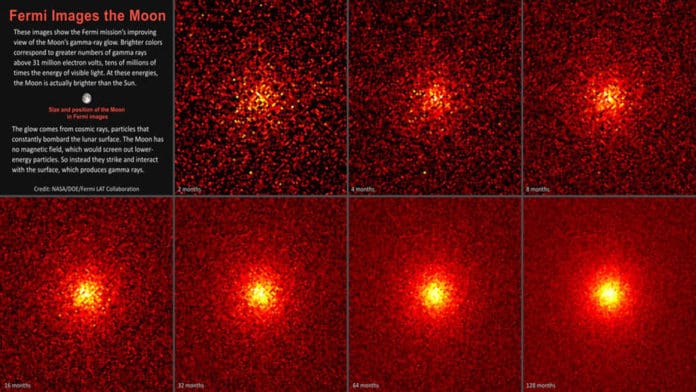Nothing can beat the brightness of Sun, but in a set of new images captured by NASA’s Fermi space telescope, the moon seems to glow brighter than the sun.
NASA’s Fermi space telescope enables us to see high-energy radiation called gamma rays, which cause the moon to seem to have an extreme glow as a result of its gamma-ray outflows.
Mario Nicola Mazziotta and Francesco Loparco, both at Italy’s National Institute of Nuclear Physics in Bari, have been analyzing the Moon’s gamma-ray glow as a way of better understanding another type of radiation from space: fast-moving particles called cosmic rays.

Mazziotta said, “Cosmic rays are mostly protons accelerated by some of the most energetic phenomena in the universe, like the blast waves of exploding stars and jets produced when matter falls into black holes.”
At the point when cosmic rays strike the moon, they produce gamma-ray emissions. In this way, from the gamma-ray telescope’s perspective, the moon turns into a clever locator for cosmic ray particles.
Scientists examined Fermi-LAT lunar observations to indicate how the view has improved during the mission. They gathered the information for gamma rays with energies over 31 million electron volts — above 10 million times greater than the energy of visible light — and sorted out them after some time, indicating how longer exposures improve the view.
In spite of their electric charge, cosmic rays can arrive at the surface of the moon without escaping getting pushed away as the moon does not have a magnetic field. In the interim, the sun’s powerful magnetic field blocks numerous cosmic rays (aside from those with unfathomably high vitality), making less gamma-ray emissions shimmer in the telescope photographs.
These gamma-ray observations are a reminder that astronauts on the Moon will require protection from the same cosmic rays that produce this high-energy gamma radiation.
While the Moon’s gamma-ray glow is surprising and impressive, the Sun does shine brighter in gamma rays with energies higher than 1 billion electron volts. Cosmic rays with lower energies do not reach the Sun because its powerful magnetic field screens them out. But much more energetic cosmic rays can penetrate this magnetic shield and strike the Sun’s denser atmosphere, producing gamma rays that can reach Fermi.
Although the gamma-ray Moon doesn’t show a monthly cycle of phases, its brightness does change over time. Fermi-LAT data show that the Moon’s light varies by about 20% over the Sun’s 11-year activity cycle. Variations in the intensity of the Sun’s magnetic field during the cycle change the rate of cosmic rays reaching the Moon, altering the production of gamma rays.
